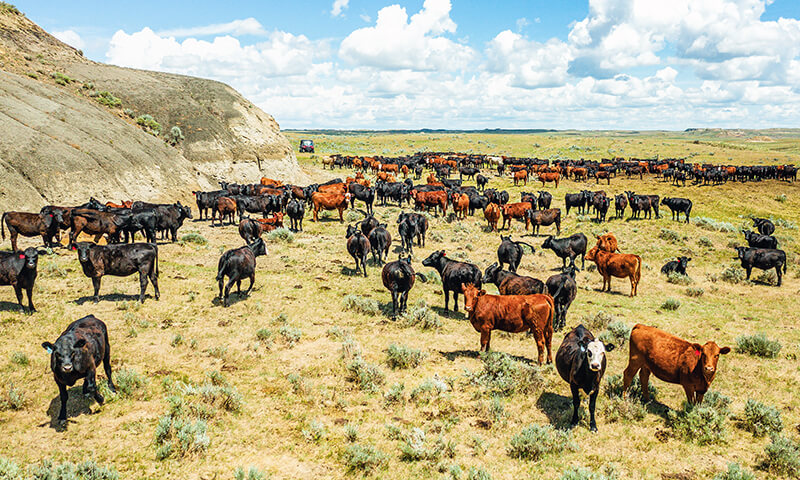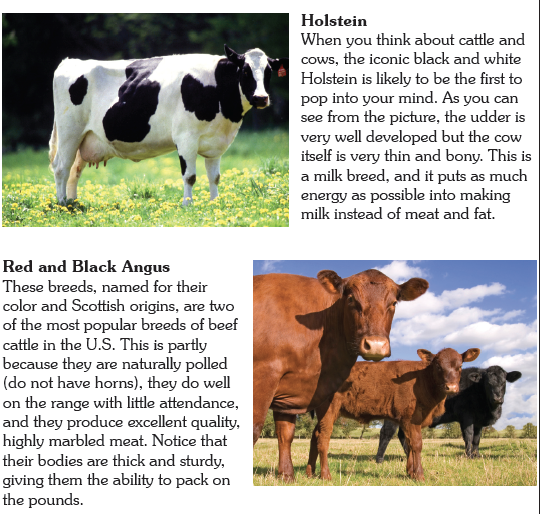Beef Basics
Students explain the value of the beef cattle industry, including the products cattle produce, the production process from farm to plate, and how cattle can utilize and obtain energy from grass and other forage.

Background
Lesson Activities
Recommended Companion Resources
Credits
Author
Lynn Wallin | Utah Agriculture in the Classroom
Sources
- https://www.usatoday.com/story/money/2017/07/03/americans-eat-more-beef-and-meat-trend-thats-expected-continue/435331001/
- https://www.huffingtonpost.com/2013/07/28/burger-facts-trivia_n_3654636.html
- http://beef2live.com/story-ranking-states-beef-cows-0-108181
Standards
Texas Content Area Standards
-
ELA: 4.110.6.b.1
Developing and sustaining foundational language skills: listening, speaking, discussion, and thinking- oral language. The students develops oral language through listening, speaking, and discussion.
- ELA: 4.110.6.b.1.D: work collaboratively with others to develop a plan of shared responsibilities
-
Social Studies: 3.113.14.c.14
Social studies skills. The student applies critical-thinking skills to organize and use information acquired from a variety of valid sources, including technology. The student is expected to:
- Social Studies: 3.113.14.c.14.C: interpret oral, visual, and print material by sequencing, categorizing, identifying the main idea, distinguishing between fact and opinion, identifying cause and effect, comparing, and contrasting
-
Social Studies: 3.113.14.c.15
Social studies skills. The student communicates in written, oral, and visual forms. The student is expected to:
- Social Studies: 3.113.14.c.15.D: express ideas orally based on knowledge and experiences
-
Social Studies: 3.113.14.c.16
Social studies skills. The student uses problem-solving and decision-making skills, working independently and with others. The student is expected to:
- Social Studies: 3.113.14.c.16.B: use problem-solving and decision-making processes to identify a problem, gather information, list and consider options, consider advantages and disadvantages, choose and implement a solution, and evaluate the effectiveness of the solution
-
Social Studies: 4.113.15.c.19
Social studies skills. The student applies critical-thinking skills to organize and use information acquired from a variety of valid sources, including technology. The student is expected to:
- Social Studies: 4.113.15.c.19.C: analyze information by applying absolute and relative chronology through sequencing, categorizing, identifying cause-and-effect relationships, comparing, contrasting, finding the main idea, summarizing, making generalizations and predictions, and drawing inferences and conclusions;
-
Social Studies: 4.113.15.c.21
Social studies skills. The student communicates in written, oral, and visual forms. The student is expected to:
- Social Studies: 4.113.15.c.21.C: express ideas orally based on research and experiences
-
Social Studies: 4.113.15.c.22
Social studies skills. The student uses problem-solving and decision-making skills, working independently and with others. The student is expected to:
- Social Studies: 4.113.15.c.22.B: use problem-solving and decision-making processes to identify a problem, gather information, list and consider options, consider advantages and disadvantages, choose and implement a solution, and evaluate the effectiveness of the solution
-
Social Studies: 5.113.16.c.23
Social studies skills. The student applies critical-thinking skills to organize and use information acquired from a variety of valid sources, including technology. The student is expected to:
- Social Studies: 5.113.16.c.23.C: analyze information by applying absolute and relative chronology through sequencing, categorizing, identifying cause-and-effect relationships, comparing, contrasting, finding the main idea, summarizing, making generalizations and predictions, and drawing inferences and conclusions
-
Social Studies: 5.113.16.c.25
Social studies skills. The student communicates in written, oral, and visual forms. The student is expected to:
- Social Studies: 5.113.16.c.25.C: express ideas orally based on research and experiences
-
Social Studies: 5.113.16.c.26
Social studies skills. The student uses problem-solving and decision-making skills, working independently and with others. The student is expected to:
- Social Studies: 5.113.16.c.26.B: use problem-solving and decision-making processes to identify a problem, gather information, list and consider options, consider advantages and disadvantages, choose and implement a solution, and evaluate the effectiveness of the solution
-
Science: 3.112.5.b.1
Scientific and engineering practices. The student asks questions, identifies problems, and plans and safely conducts classroom, laboratory, and field investigations to answer questions, explain phenomena, or design solutions using appropriate tools and models. The student is expected to:
- Science: 3.112.5.b.1.A: ask questions and define problems based on observations or information from text, phenomena, models, or investigations
-
Science: 3.112.5.b.3
Scientific and engineering practices. The student develops evidence-based explanations and communicates findings, conclusions, and proposed solutions. The student is expected to:
- Science: 3.112.5.b.3.A: develop explanations and propose solutions supported by data and models
-
Science: 3.112.5.b.5
Recurring themes and concepts. The student understands that recurring themes and concepts provide a framework for making connections across disciplines. The student is expected to:
- Science: 3.112.5.b.5.E: investigate the flow of energy and cycling of matter through systems
-
Science: 3.112.5.b.11
Earth and space. The student understands how natural resources are important and can be managed. The student is expected to:
- Science: 3.112.5.b.11.B: explain why the conservation of natural resources is important
- Science: 3.112.5.b.11.C: identify ways to conserve natural resources through reducing, reusing, or recycling
-
Science: 4.112.6.b.1
Scientific and engineering practices. The student asks questions, identifies problems, and plans and safely conducts classroom, laboratory, and field investigations to answer questions, explain phenomena, or design solutions using appropriate tools and models. The student is expected to:
- Science: 4.112.6.b.1.A: ask questions and define problems based on observations or information from text, phenomena, models, or investigations
-
Science: 4.112.6.b.3
Scientific and engineering practices. The student develops evidence-based explanations and communicates findings, conclusions, and proposed solutions. The student is expected to:
- Science: 4.112.6.b.3.A: develop explanations and propose solutions supported by data and models
-
Science: 4.112.6.b.5
Recurring themes and concepts. The student understands that recurring themes and concepts provide a framework for making connections across disciplines. The student is expected to:
- Science: 4.112.6.b.5.E: investigate the flow of energy and cycling of matter through systems
-
Science: 4.112.6.b.11
Earth and space. The student understands how natural resources are important and can be managed. The student is expected to:
- Science: 4.112.6.b.11.A: identify and explain advantages and disadvantages of using Earth's renewable and nonrenewable natural resources such as wind, water, sunlight, plants, animals, coal, oil, and natural gas
- Science: 4.112.6.b.11.B: explain the critical role of energy resources and how conservation, disposal, and recycling of natural resources impact the environment and modern life
-
Science: 4.112.6.b.12
Organisms and environments. The student describes patterns, cycles, systems, and relationships within environments. The student is expected to:
- Science: 4.112.6.b.12.A: investigate and explain how most producers can make their own food using sunlight, water, and carbon dioxide through the cycling of matter
-
Science: 5.112.7.b.1
Scientific and engineering practices. The student asks questions, identifies problems, and plans and safely conducts classroom, laboratory, and field investigations to answer questions, explain phenomena, or design solutions using appropriate tools and models. The student is expected to:
- Science: 5.112.7.b.1.A: ask questions and define problems based on observations or information from text, phenomena, models, or investigations
-
Science: 5.112.7.b.3
Scientific and engineering practices. The student develops evidence-based explanations and communicates findings, conclusions, and proposed solutions. The student is expected to:
- Science: 5.112.7.b.3.A: develop explanations and propose solutions supported by data and models
-
Science: 5.112.7.b.5
Recurring themes and concepts. The student understands that recurring themes and concepts provide a framework for making connections across disciplines. The student is expected to:
- Science: 5.112.7.b.5.E: investigate how energy flows and matter cycles through systems and how matter is conserved;
-
Science: 5.112.7.b.11
Earth and space. The student understands how natural resources are important and can be managed. The student is expected to design and explain solutions such as conservation, recycling, or proper disposal to minimize environmental impact of the use of natural resources.
- Science: 5.112.7.b.11: Earth and space. The student understands how natural resources are important and can be managed. The student is expected to design and explain solutions such as conservation, recycling, or proper disposal to minimize environmental impact of the use of natural resources.
-
Science: 5.112.7.b.12
Organisms and environments. The student describes patterns, cycles, systems, and relationships within environments. The student is expected to:
- Science: 5.112.7.b.12.A: observe and describe how a variety of organisms survive by interacting with biotic and abiotic factors in a healthy ecosystem
- Science: 5.112.7.b.12.C: describe a healthy ecosystem and how human activities can be beneficial or harmful to an ecosystem
-
ELA: 3.110.5.b.1
Developing and sustaining foundational language skills: listening, speaking, discussion, and thinking--oral language. The student develops oral language through listening, speaking, and discussion. The student is expected to:
- ELA: 3.110.5.b.1.D: work collaboratively with others by following agreed-upon rules, norms, and protocols
-
ELA: 3.110.5.b.6
Comprehension skills: listening, speaking, reading, writing, and thinking using multiple texts. The student uses metacognitive skills to both develop and deepen comprehension of increasingly complex texts. The student is expected to:
- ELA: 3.110.5.b.6.H: synthesize information to create new understanding
-
ELA: 4.110.6.b.6
Comprehension skills: listening, speaking, reading, writing, and thinking using multiple texts. The student uses metacognitive skills to both develop and deepen comprehension of increasingly complex texts. The student is expected to:
- ELA: 4.110.6.b.6.H: synthesize information to create new understanding
-
ELA: 5.110.7.b.1
Developing and sustaining foundational language skills: listening, speaking, discussion, and thinking--oral language. The student develops oral language through listening, speaking, and discussion. The student is expected to:
- ELA: 5.110.7.b.1.D: work collaboratively with others to develop a plan of shared responsibilities
-
ELA: 5.110.7.b.6
Comprehension skills: listening, speaking, reading, writing, and thinking using multiple texts. The student uses metacognitive skills to both develop and deepen comprehension of increasingly complex texts. The student is expected to:
- ELA: 5.110.7.b.6.H: synthesize information to create new understanding
